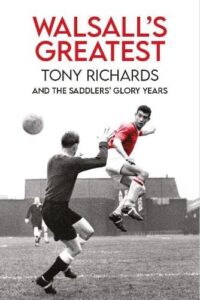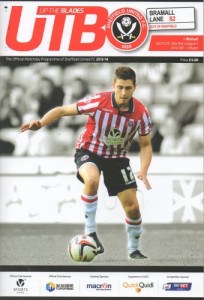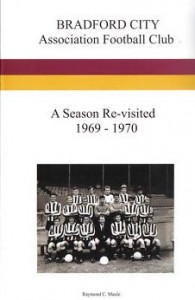Book Review – Walsall’s Greatest: Tony Richards and the Saddlers’ Glory Years by Gary Richards
 The English football pyramid top four divisions is made up of 92 clubs, however, the way that the modern media goes on you’d think that the 20 Premier League clubs are the only ones that exist. Football history in true Orwellian 1984 style has been rewritten so that all that before 1992/93 has miraculously disappeared and is never spoken about.
The English football pyramid top four divisions is made up of 92 clubs, however, the way that the modern media goes on you’d think that the 20 Premier League clubs are the only ones that exist. Football history in true Orwellian 1984 style has been rewritten so that all that before 1992/93 has miraculously disappeared and is never spoken about.
Thankfully up and down the country, thousands still attend games in the Championship, League 1 and League 2 and further down the National League System to watch their teams and ensure that their community, history and stories continue to survive and thrive.
Books like Walsall’s Greatest: Tony Richards and the Saddlers’ Glory Years by Gary Richards also thankfully add to the titles on shelves bringing to life often untold tales of players and season’s from the past.
As the PR for the book tells readers, “at the end of the 1953/54 season, Walsall Football Club finished bottom of the Third Division South and applied for re-election to the Football League for a third successive year.” What followed was an incredible change of fortunes for the West Midlands club inspired by the goalscoring talents of Tony Richards and Colin Taylor under the management of Bill Moore, which saw the Saddlers rise to the heights of the old Second Division (now Championship) taking on the likes of Leeds United, Liverpool and Newcastle United.
One thing to get out of the way is that the book is written by Tony Richards’ son Gary, but despite this, the story is told in a totally professional and objective manner and there is no mawkish sentimentality to be found amongst the pages. And yes whilst his father (who was voted Walsall’s greatest ever player in 1998) is at the centre of the story, this book is a tribute to all the players and management that brought about the club’s most successful period.
Indeed the research that the author carries out to produce this great read is to be admired as evidenced within the extensive notes section of the book. Whilst the internet can be a great source of information, it is evident that good old-fashioned trawling of newspaper archives and the like has been undertaken by Richards.’ A labour of love in more than one way. What also lends an authentic voice of the period are the interviews with Walsall players such as Keith Ball, Ray Wiggin, Trevor Foster, Stan Bennett and Nick Atthey who played with Tony Richards and bring to life the realities of the game in the 1950s and 60s.
In terms of the timeline, the book follows a convention path looking at Tony Richard’s upbringing, his early youth career at Birmingham City and his army days before his move to Walsall for the 1954/55 season. It then follows through the various Saddlers campaigns to 1963 when after 334 games scoring 185 goals, he left for Port Vale (1963 to 1966) and finished his career in non-league with Nuneaton Borough (1966 to 1969) where despite injuries Richards’ continued his incredible scoring prowess.
Whilst the book focuses very much on the story of Walsall’s rise at that time, the author also provides readers with some interesting comparisons about football then and now, thereby challenging some of the assumptions and perceptions of the game back in the day.
Sadly Tony Richards passed away in March 2010 aged 75 after suffering with dementia. Tony Richards’ was famous for his aerial ability and headed goals, especially the now not often seen diving header. And in one of the closing chapters Gary makes a serious point about how that continuous heading combined with playing at the time with heavier balls, no substitutes, concussion protocols or data research, inevitably contributed to the illness that afflicted his father. It’s a sobering and thought provoking chapter in a book that is otherwise a celebration of the beautiful game – one that is of course a book that is aimed at Walsall fan’s but will undoubtedly have a wider reach for those wanting an insight into the game and it environment in the 1950s and early 60s.
(Publisher: ToneRedDays. April 2022. Paperback: 255 pages)
Buy the book here: https://www.walsallfcstore.co.uk/product/walsalls-greatest-tony-richards/
 In recent years, Paul Merson has stuck his head above the parapet to speak openly, honestly, movingly and at times heartbreakingly about his struggles with addiction, and his latest book, Hooked, delves more deeply into these issues, his troublesome relationship with alcohol, drugs and gambling and his long and continuing road to recovery. For all of the brilliance of the man on the pitch, his greatest contribution may be off it, with a book that helps readers understand the illness that is addiction and hopefully speaks to those who really need it.
In recent years, Paul Merson has stuck his head above the parapet to speak openly, honestly, movingly and at times heartbreakingly about his struggles with addiction, and his latest book, Hooked, delves more deeply into these issues, his troublesome relationship with alcohol, drugs and gambling and his long and continuing road to recovery. For all of the brilliance of the man on the pitch, his greatest contribution may be off it, with a book that helps readers understand the illness that is addiction and hopefully speaks to those who really need it. For me, a great autobiography gives a reader a really authentic, honest insight into the individual and helps them understand that person more. When the subject of the autobiography is particularly complex and nuanced and someone you haven’t necessarily been able to connect with or relate to before, yet you come away from the book with recognition and perspective, that’s all the more telling of a successful autobiography, and in that respect Troy Deeney’s Redemption excels. Deeney is one of those players that is perhaps largely misunderstood, divisive and dismissed for those without a Watford affiliation and, certainly, I would be guilty of being drawn into this narrative, so I was really intrigued to read this book and came away from it with genuine renewed understanding for Deeney.
For me, a great autobiography gives a reader a really authentic, honest insight into the individual and helps them understand that person more. When the subject of the autobiography is particularly complex and nuanced and someone you haven’t necessarily been able to connect with or relate to before, yet you come away from the book with recognition and perspective, that’s all the more telling of a successful autobiography, and in that respect Troy Deeney’s Redemption excels. Deeney is one of those players that is perhaps largely misunderstood, divisive and dismissed for those without a Watford affiliation and, certainly, I would be guilty of being drawn into this narrative, so I was really intrigued to read this book and came away from it with genuine renewed understanding for Deeney. Hooked is Merson’s wonderfully moving and brutally honest memoir of battling addiction, unflinching in detailing his emotional and psychological troughs and in raking over the painful embers of an adult life blighted by such debilitating issues.
Hooked is Merson’s wonderfully moving and brutally honest memoir of battling addiction, unflinching in detailing his emotional and psychological troughs and in raking over the painful embers of an adult life blighted by such debilitating issues.


 Kick-off was delayed ten minutes at Bramall Lane due to a fire-alarm problem, although after a game low on quality and incident, fans might have wished it had been postponed indefinitely.
Kick-off was delayed ten minutes at Bramall Lane due to a fire-alarm problem, although after a game low on quality and incident, fans might have wished it had been postponed indefinitely.
